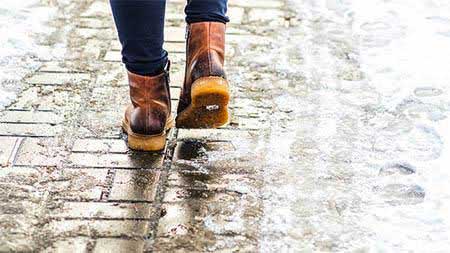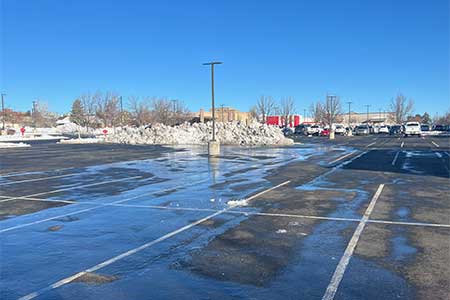Winter in Denver brings not only picturesque snow-covered landscapes but also unique challenges for commercial property owners. One significant concern is the fluctuation between freezing temperatures and thawing conditions, which can pose various risks to property safety.
Let’s delve into the dangers associated with freezing and thawing and provide practical strategies to ensure the safety of your commercial property.

Understanding Freeze-Thaw Property Risks in Colorado
Denver’s winter weather is characterized often by its quickly fluctuating temperatures, where periods of freezing cold alternate with milder temperatures, leading to thawing. This cycle, known as Freeze-Thaw, can result in a range of hazards for commercial properties.
The freeze-thaw cycle can cause structural damage, such as cracks in pavements and foundations, which pose risks to property integrity and occupant safety.
Potential Freeze-Thaw Hazards for Commercial Properties
- Structural Damage: Freeze-thaw cycles can weaken building materials, leading to cracks in walls, floors, and foundations.
- Slip and Fall Accidents: Thawing snow and ice can create slippery surfaces on walkways and parking lots, increasing the risk of slip and fall accidents for employees, customers, and visitors.
- Roof Damage: Ice dams formed by freezing and thawing can accumulate on roofs, leading to water infiltration and potential structural damage.
- Burst Pipes: Freezing temperatures can cause pipes to freeze and burst, resulting in water damage to the property’s interior and infrastructure.

Safety Measures to Mitigate Freeze-Thaw Risks
- Risk Assessments: In addition to implementing a proactive snow and ice removal plan, it is imperative that your contractor takes all factors into account when developing Snow Management Maps, especially as it relates to pile locations. Aside from the obvious avoidances – don’t pile snow near buildings, don’t cover fire hydrants and avoid piling snow on north sides – drain location and slope of parking lot are important aspects to identify and plan for.
Although a big pile of snow looks cool, if that big pile of snow is 200’ uphill from the nearest drain it is going to create a large flow of melting water that will freeze at night. This will create extremely dangerous situations for tenants, employees, and visitors to the property. Whereas property owners would prefer to have snow on the outer edges of a lot, when weighing the risk of slip and fall liability against the availability of certain parking spots, one might realize that getting the snow closer to the drain will actually improve the overall functionality of the site and the people and vehicles coming and going.
- Regular Maintenance: Schedule routine inspections to identify and address any structural weaknesses or damage promptly.
- Snow and Ice Removal: Implement a proactive snow and ice removal plan to keep walkways, parking lots, and building entrances clear and safe.
- Roof Inspections: Conduct regular inspections of the roof to identify and address any ice dams or potential leaks.
- Insulation and Heating: Ensure that pipes are properly insulated and that heating systems are functioning effectively to prevent freezing and bursting.
- Safety Training: Provide employees with training on winter safety protocols, including proper footwear and techniques for navigating icy surfaces.
- Ice Watch(Monitoring): When slope and drain locations just don’t play nice together, and even the most well thought out pile maps can’t solve all the problems(see building downspouts) an effective tool is to implement an Ice Watch program. This allows your contractor to go out for a set number of nights after a snow event to patrol for areas that have melted and refroze. In doing so, the site is safe and buys additional time for those difficult snow piles to melt off.
Colorado’s freeze-thaw cycles can pose significant risks to commercial properties during winter. By understanding these risks and implementing proactive safety measures, property owners can minimize hazards and ensure the safety of occupants and visitors. Regular maintenance, snow and ice removal, roof inspections, and proper insulation are essential steps in safeguarding commercial properties against the dangers of freezing and thawing.
Snowology has a dedicated and highly experienced team the considers all the factors to protect your property through Denver’s tough winters. Don’t hesitate to contact us to assist in you winter risk assessment or commercial snow removal.
